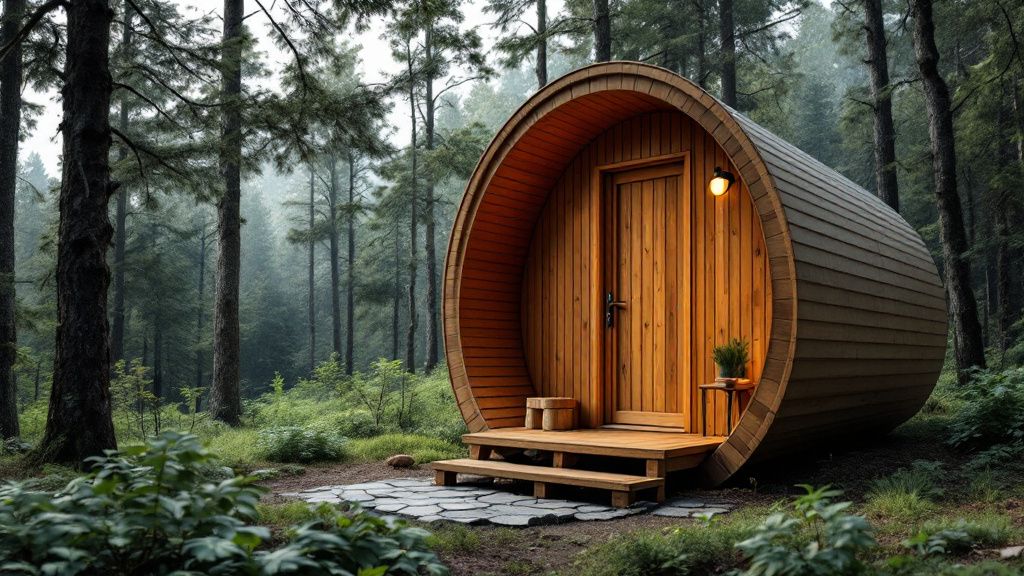Selecting the ideal fuel source for your off-grid sauna is a pivotal decision in creating the perfect sanctuary hidden from the bustling world. You must consider several factors to make an informed choice that fits your lifestyle and environment. Understanding different sauna wood types can significantly impact the ambience and performance of your sauna. Hardwood varieties such as oak, maple, and birch are excellent due to their long burn times and consistent heat output. Meanwhile, softwoods like pine ignite more quickly, providing an initial burst of heat. Each wood type offers distinct characteristics and experiences, so it's essential to align your selection with your desired sauna atmosphere.
As you explore the best fuel source, think about the accessibility and sustainability of your chosen material. For example, if you live in an area where hardwood is abundant, it might be the most practical and environmentally friendly option. Alternatively, for those who prefer a less labor-intensive approach, propane or solar energy might be appealing choices with minimal upkeep. Assess the balance between the warmth you seek and the convenience you desire, ensuring that your decision enhances the overall serenity and efficiency of your off-grid escape.

Understanding Off Grid Saunas
Off-grid saunas offer a blissful retreat for those seeking a natural escape from modern conveniences, allowing you to connect with the essence of traditional sauna experiences. These structures typically function independently of conventional power sources, facilitating a connection to nature's rhythms. Tracing their evolution from ancient Finnish outbuildings known as "savusaunas," off-grid saunas have maintained their core purpose: providing a rejuvenating space for physical and mental relaxation. As you consider fuel sources, understanding this heritage helps you appreciate the wisdom behind using natural materials, such as various sauna wood types, to enhance the therapeutic benefits.
The charm of off-grid saunas lies in their simplicity and versatility. They can be adapted to diverse environments, whether nestled in a dense forest or perched on a remote mountain. This adaptability requires careful consideration of the best fuel source that suits both the setting and your personal preferences. Whether you choose the slow-burning reliability of hardwood or the innovative use of solar energy, your choice reflects a balance between honoring tradition and embracing modern sustainability. As you explore these options, consider how each fuel source contributes to the holistic experience that off-grid saunas uniquely offer.

Types of Fuel Sources Available
Wood, one of the most traditional fuel sources, offers a cozy and aromatic experience for off-grid saunas. Using hardwoods like oak or birch ensures a steady and long-lasting heat, perfect for leisurely sauna sessions. Meanwhile, softer woods such as pine ignite swiftly and can provide a satisfying, crackling ambiance. It's worth considering how different sauna wood types contribute distinct essences to your sauna retreat as you select your option.
Propane provides an efficient, controllable heat source with consistent results regardless of weather conditions. This fuel is especially beneficial in regions with colder climates or where wood supplies may be less accessible. Imagine propane as a well-tuned orchestra conductor, ensuring that the temperature inside your sauna remains perfectly in harmony. It operates seamlessly when combined with modern off-grid setups, offering reliability throughout the season.
Solar power represents an innovative and sustainable choice for heating an off-grid sauna. This eco-friendly method harnesses the sun's energy, making it appealing to those conscious of their environmental footprint. By installing solar panels, you can convert sunlight into renewable energy for heating. Just like a sunlit day invigorates the soul, solar energy provides a clean and limitless source for your sauna needs.
For more remote locations, a combination of multiple sources might be most effective. Utilizing a primary fuel type, such as wood or propane, along with solar can maximize efficiency and ensure your sauna stays ready for use. By considering how each fuel source meets your specific needs and setting, you can craft a personalized energy solution that complements your off-grid lifestyle.

Evaluating Your Location's Resources
Assessing the available resources in your location is crucial when selecting the best fuel source for your off-grid sauna tent. Consider the abundance or scarcity of local materials like wood, as this can directly influence your choice. In densely wooded areas, using local hardwoods like oak or maple can be both cost-effective and environmentally sustainable. If your region lacks such resources, alternative options may better suit your needs.
The local climate plays a significant role in determining the most practical fuel source. Colder climates might benefit from propane's reliable and intense heat, whereas solar energy can be advantageous in sunnier regions. What most people don’t see about fuel source selection is the subtle balance between nature's offerings and technological advancements that makes all the difference. Embracing this balance ensures optimal performance for your off-grid sauna.
Accessibility to your chosen fuel is another consideration. Remote locations might challenge your ability to transport heavy firewood or install solar panels. In these scenarios, selecting the best fuel source involves evaluating logistical constraints. Opt for solutions that minimize transportation hassles, like using indigenous materials or multi-use technologies, contributing to a harmonious and sustainable sauna experience tailored to your location's profile.

Cost Considerations When Choosing Fuel
When selecting a fuel source for your off-grid sauna, evaluating the financial impact is a key factor. Fuel costs vary significantly, with wood often being one of the more economical options if you have access to abundant local woodlands. Harvesting your own wood can dramatically reduce expenses, although it requires time and effort. Purchasing hardwood, like oak or birch, on the other hand, introduces an ongoing expense but offers consistent heat and longevity.
Propane's appeal lies in its convenience, but it can come with a higher price tag, both in fuel costs and in investment for tanks and distribution systems. According to recent studies, the efficiency gains from propane can offset higher initial expenses, particularly in regions prone to harsh winters. This scientific finding explains how propane systems cater to consistent energy demands, balancing upfront costs with operational efficiency.
Solar energy sets itself apart with minimal operational costs, although the initial investment can be substantial. Solar panels and related technology might require a larger upfront expenditure, but they promise virtually endless free energy in sunny locales. This setup capitalizes on renewable energy advantages, an alluring option for those prioritizing eco-friendliness while eyeing long-term savings associated with green technologies.

Safety and Maintenance of Fuel Sources
Ensuring the safety and proper maintenance of your chosen fuel source is essential for a trouble-free sauna experience. When using wood, it's important to regularly clean the stove and chimney to prevent creosote buildup, which can pose a fire hazard. Opting for seasoned wood minimizes smoke and emissions, protecting both your health and the integrity of your sauna's structure. Consistent upkeep translates to a safer and more efficient heating process.
Propane systems, while convenient, require careful monitoring to ensure safety. Regular inspections of tanks, lines, and regulators are crucial to prevent leaks that could lead to hazardous situations. Implementing these safety checks guards against potential dangers, maintaining a secure environment in your off-grid sauna. In the next few years, propane technology is likely to advance, promising even greater safety and efficiency measures for saunas globally.
For solar-powered saunas, routine maintenance of solar panels is key to maximizing efficiency. This involves cleaning panels to ensure optimal sunlight absorption and periodically checking connections. As renewable energy technology progresses, advancements in solar efficiency are on the horizon, potentially reducing maintenance needs and enhancing sustainability. Investing time in maintenance will keep your sauna running smoothly, providing a consistent and peaceful retreat.

